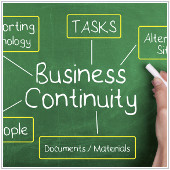While there is a lot of information out there about how to gain value from LinkedIn, most of it is aimed at large companies or individuals. Some of this information can be useful, but some of it can cause you to make mistakes that present your business in the wrong light. As an SMB owner, […]
 While there is a lot of information out there about how to gain value from LinkedIn, most of it is aimed at large companies or individuals. Some of this information can be useful, but some of it can cause you to make mistakes that present your business in the wrong light. As an SMB owner, you need to utilize LinkedIn in a way that matches your business size. That’s why we’ve provided these tips catered to SMBs who want to gain more value from their time spent on LinkedIn.
While there is a lot of information out there about how to gain value from LinkedIn, most of it is aimed at large companies or individuals. Some of this information can be useful, but some of it can cause you to make mistakes that present your business in the wrong light. As an SMB owner, you need to utilize LinkedIn in a way that matches your business size. That’s why we’ve provided these tips catered to SMBs who want to gain more value from their time spent on LinkedIn.
Know LinkedIn’s purpose
Simply put, LinkedIn is not a content marketing platform. Yes, people do publish articles and posts, but if you have a small budget and are short on time, you will get more bang for your buck on social media networks that are more content marketing friendly. For example, Pinterest, Instagram, Facebook and Twitter are all far better options in this scenario. Many users are on these platforms to view content in one form or another. On LinkedIn, content can undoubtedly be viewed, but people are primarily there to make connections. Of course that doesn’t mean you shouldn’t post an occasional article on LinkedIn. It just means don’t make it the main source of your content marketing efforts.Another way businesses misconceive LinkedIn is in terms of lead generation. Basically, you shouldn’t expect your LinkedIn page to generate a large amount of leads. As an SMB, your marketing budget is limited, so you’ll be better off using your advertising budget to drive leads to your actual website or even a Facebook business page. Your LinkedIn business page should be used instead to validate your experience, credentials, and professionalism. With that said, make sure your page is polished and updated with all this information.
Double down on business trips
We all know that LinkedIn is a great platform to connect with business colleagues. If you’re active on the platform, you likely have hundreds of connections. So when you make that next business trip, why not tap your network to book additional meetings in the city you’re traveling to? Ask yourself, which of your connections could help you extend your sales in that region or benefit your business in some other way? You don’t have to stick to business colleagues you know personally. You can create valuable new relationships by tapping your current LinkedIn network. To do this, search first and second degree connections using the geographic search option, and filter your results to job titles, industry, and company size of your ideal prospect. Once you’ve found potential contacts, see if you can get an introduction from one of your first connections, or simply InMail them and reach out yourself.Your page is about your business—not you
A very common small business mistake on LinkedIn is making your company page about you, not your business. You may mistakenly create this page like your personal profile, listing accolades and job experience. What you should really be focusing on, however, is something much bigger: the story of your business or brand. A story will help engage your prospects, creating an impression in their minds, and also give you an opportunity to touch on the value your business provides to customers. Your profile should also include some of the top brands your business has helped. If one of your clients is Target, The Gap, Whole Foods or another big name, make sure to mention it, as it proves your credibility as a business or service provider.Find talented hires
While big companies have the budget and time to post job openings on LinkedIn, as an SMB, there’s a good chance you’re lacking both. Fortunately, there’s an alternative way to find top talent on LinkedIn. Simply search for them yourself.Before you get started, you need to know exactly what kind of hire you’re looking for. Think about people you already know who would be perfect for the job. While you may not have the ability or budget to hire them, look them up on LinkedIn and see their career path. What kind of roles did this person previously have? What kind of experience did he or she have before their current position? With this information in hand, now you can search for people who are in or have held similar positions, and will likely share qualities of your ideal candidate. Once you have a pool of potential applicants, reach out to them through InMail or a shared connection to see if they’re interested in your job.
Ask for help, and be helpful
Like all social media platforms, if you don’t engage with your connections, you’ll see little value generated from your time using it. However, with LinkedIn, the type of engagement you participate in can be extremely valuable for your business. All it requires is for you to ask for help or feedback. For example, if you have several logo designs for a new product and are unsure of which is best, share some of them with your network to get feedback. If you’re curious about a new productivity tool and wonder if it’s worth investing in, ask your network if anyone’s used it before. Oftentimes in the business world, people are happy to help you if you just speak up. However, don’t forget to return the favor. If you become the person who seems to only be taking advice without giving any in return, it can have a negative effect on your reputation.If you’d like more ideas on how social media or technology can create value for your business, don’t hesitate to get in touch. Our IT solutions can help you overcome challenges, and create an even more valuable business.



